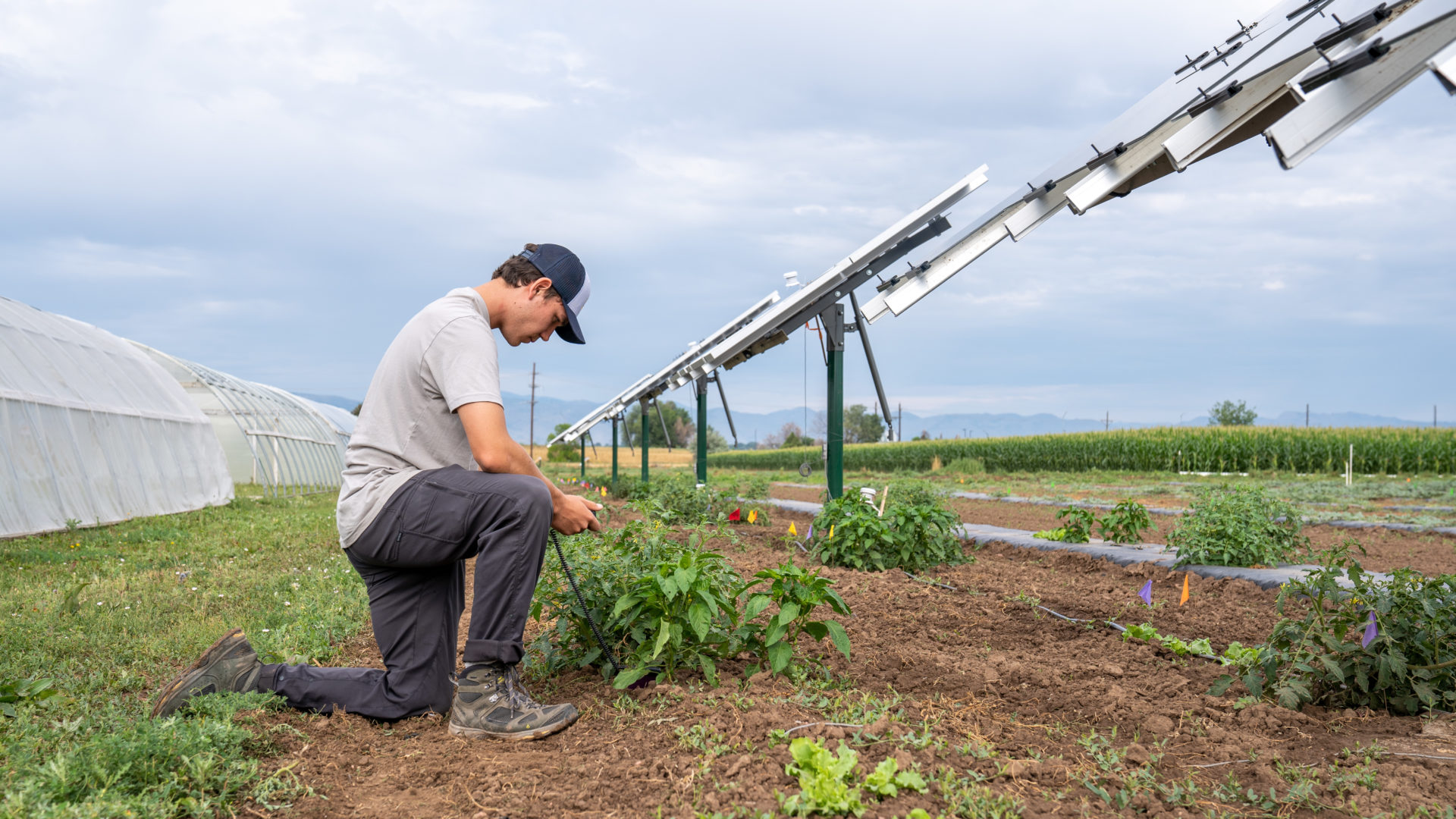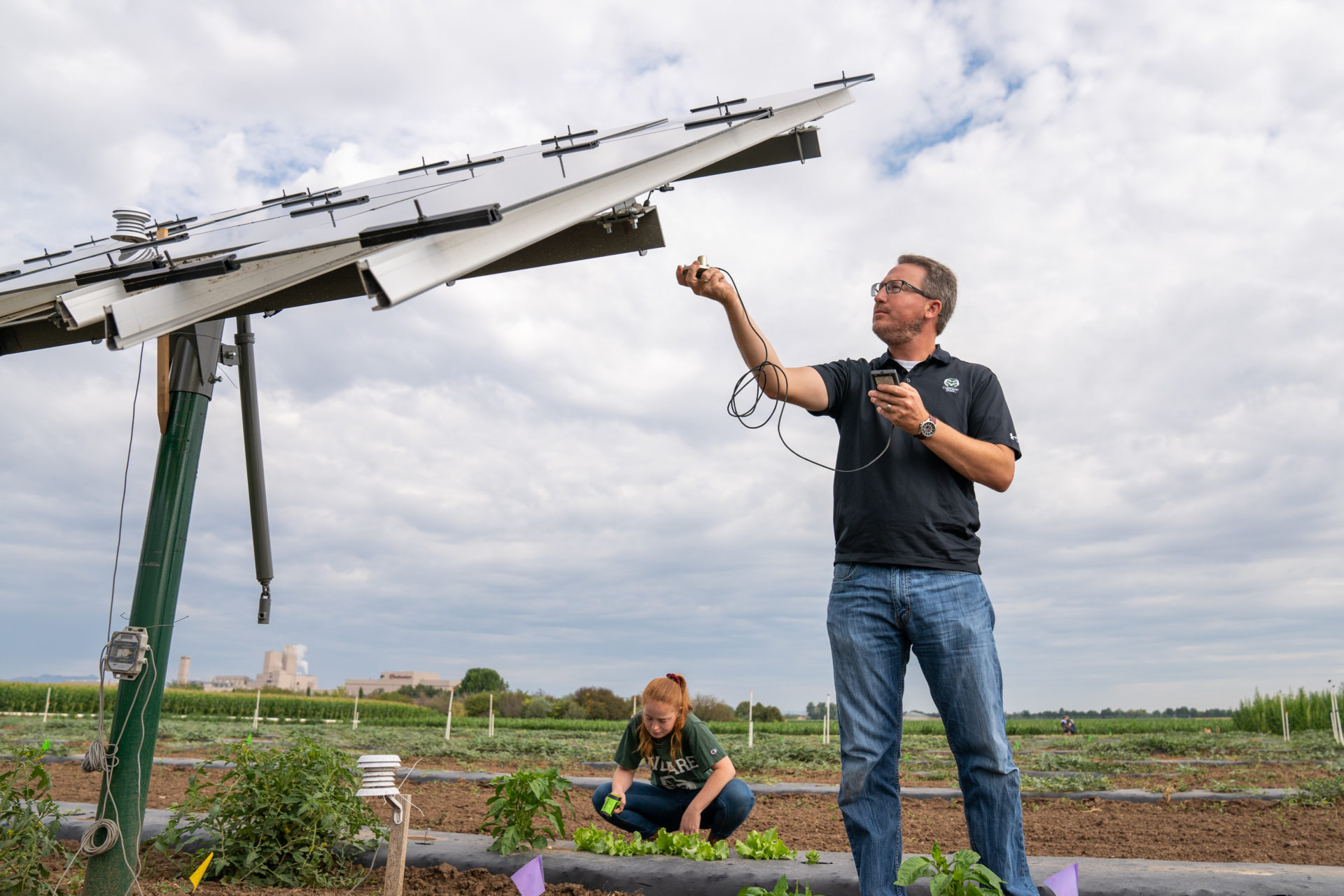On a stretch of cultivated land at the CSU Horticultural Field Research Center, a neat row of solar panels towers over small plots of lettuce and other vegetables.
The gentle shadows that cast over the mini gardens are no accident. They’re part of a carefully controlled experiment testing whether specialty crops like tomatoes, peppers, and kale can grow in, or even benefit from, close proximity with solar energy generation.
The research is a collaborative effort between Mark Uchanski, associate professor in Colorado State University’s Department of Horticulture and Landscape Architecture, and Sandbox Solar, a Fort Collins solar energy startup with offices in the CSU Powerhouse Energy Campus. The team is supported by a grant from the U.S. Department of Agriculture’s National Institute of Food and Agriculture.
Awarded earlier this year to Sandbox Solar, the Small Business Innovation Research program grant is supporting a market study evaluating whether integrating photovoltaics into horticultural spaces – a burgeoning field known as agrivoltaics – would be a cost benefit to farmers and growers. To bring scientific validation to the premise, the Sandbox Solar team recruited Uchanski, who heads CSU’s specialty crops research program, to partner on a controlled study of vegetables grown underneath and around different types of solar panels. USDA-designated “specialty crops” include fruits, vegetables, tree nuts and various nursery crops and flowers.
“How does solar co-locate with agricultural production? Are they in conflict? Is there a benefit? Quite frankly, I said, ‘This is a little bit crazy, but let’s try it,’” Uchanski said.
It started with one panel
Preliminary data-gathering began about two years ago with one panel installed inside a CSU greenhouse, leading to the fuller-scale effort now ongoing at CSU’s Agricultural Research, Development and Education Center South (ARDEC South).
Earlier this year, Sandbox Solar installed solar panels above repeating plots of lettuce, tomatoes, kale, peppers, and spinach. Three panel-less plots act as experimental controls. The types of panels also vary, from traditional opaque polycrystalline-silicon ones, to newer-style “bifacial” ones that are semi-transparent and generate electricity from both the front and back. Others are made out of translucent cadmium telluride, a cutting-edge material with close ties to CSU engineering research that holds promise for increasing light-to-energy efficiency by orders of magnitude.
“The question is not only whether we can grow crops under these solar panels, but if we can create a business model where local farmers can benefit from symbiotically producing two resources out of the same piece of land,” said Ian Skor, co-founder of Sandbox Solar.
To find out, Uchanski’s team toiled over the summer planting, weeding, and taking detailed measurements. Data points include the temperature of the soil underneath and on top of the panels, as well as the quality of light coming through the panels and hitting the plants underneath. They are observing how the panels influence water distribution around the crops, and whether water lines created by the panels’ edges might increase or decrease crop yield. Finally, they’re monitoring whether the plants could also be good for the panels by creating a microenvironment that prevents the panels from overheating.



Left: Tom Hickey, Sandbox Solar employee and College of Agricultural Sciences alumnus. Center: Hickey, Uchanski and undergraduate student Zoe Neale. Right: Uchanski and Neale take measurements of panels and crops.
Better, or acceptable yields
The researchers are paying close attention to the plants directly under the panels, which are not exposed to direct sunlight. They hypothesize, for example, that light through a translucent panel might improve lettuce growth, which has shallow roots and prefers cooler temperatures.
But even if the panels prove to slightly decrease yield, the researchers are also helping to evaluate whether producing electricity and crops together makes sense at all.
“Even if we have a little bit of yield reduction, it may be within acceptable limits,” Uchanski said.
Perhaps one day, Uchanski added, solar panels on farms will be like the high tunnels that provide partial cover for some crops, and that just a decade ago were not as ubiquitous as they are today.
And here’s an added benefit the researchers didn’t necessarily expect: During a major hailstorm in early July, the crops under the panels were shielded from the golf balls raining from the sky.
“The panels were unscathed, and the crops under them were protected,” Uchanski said. “This will show up in our data.”
The researchers plan to complete the project by early 2020.